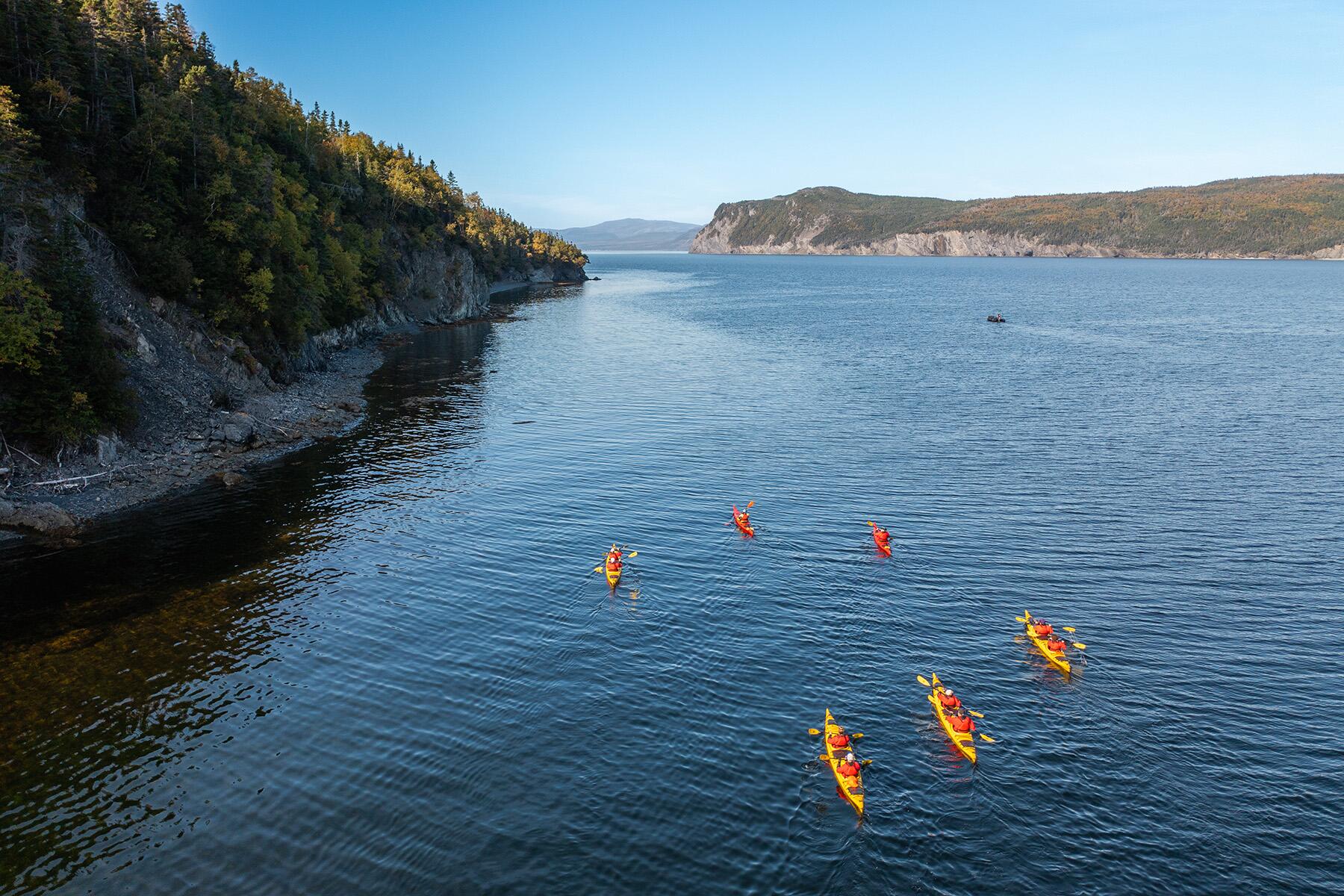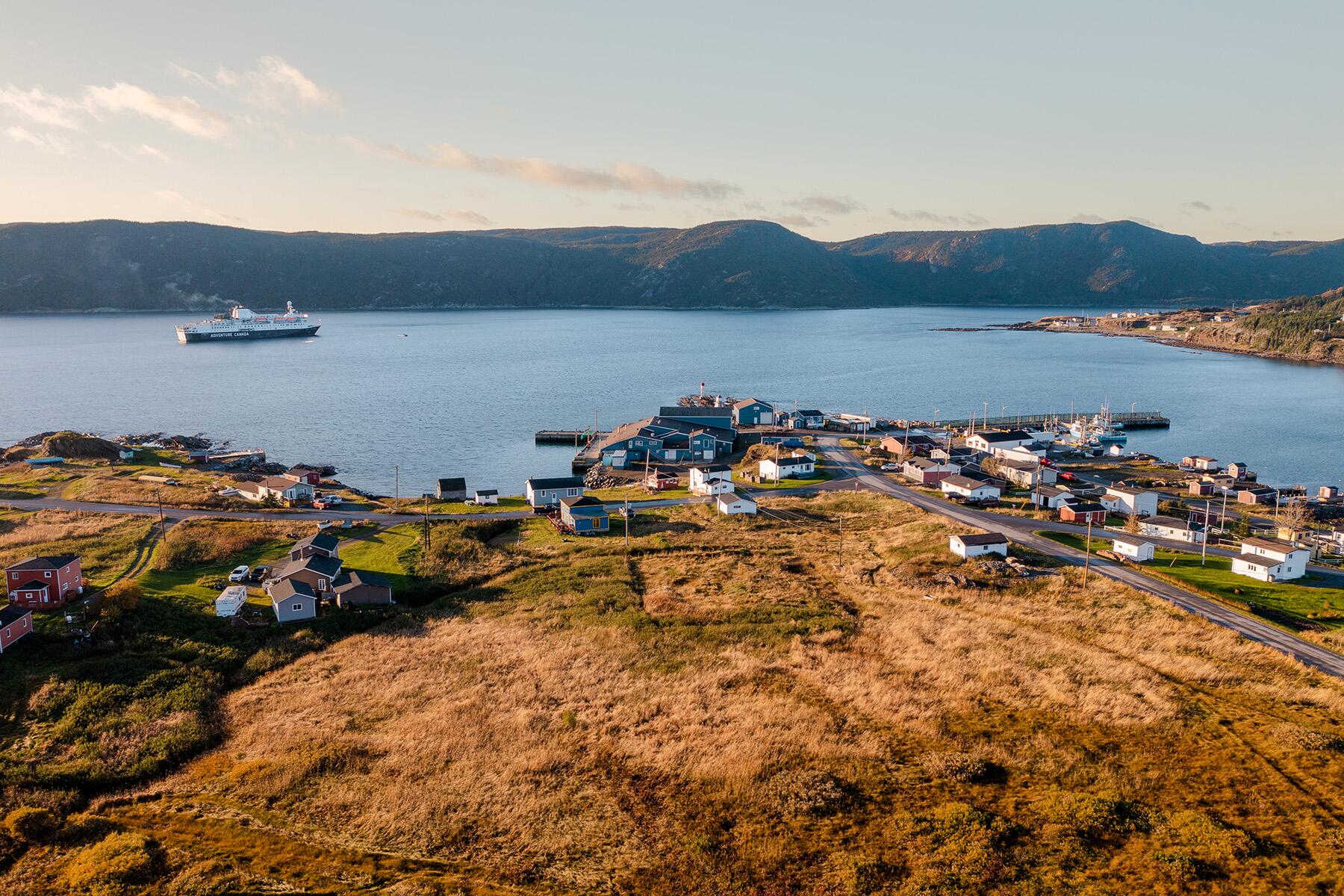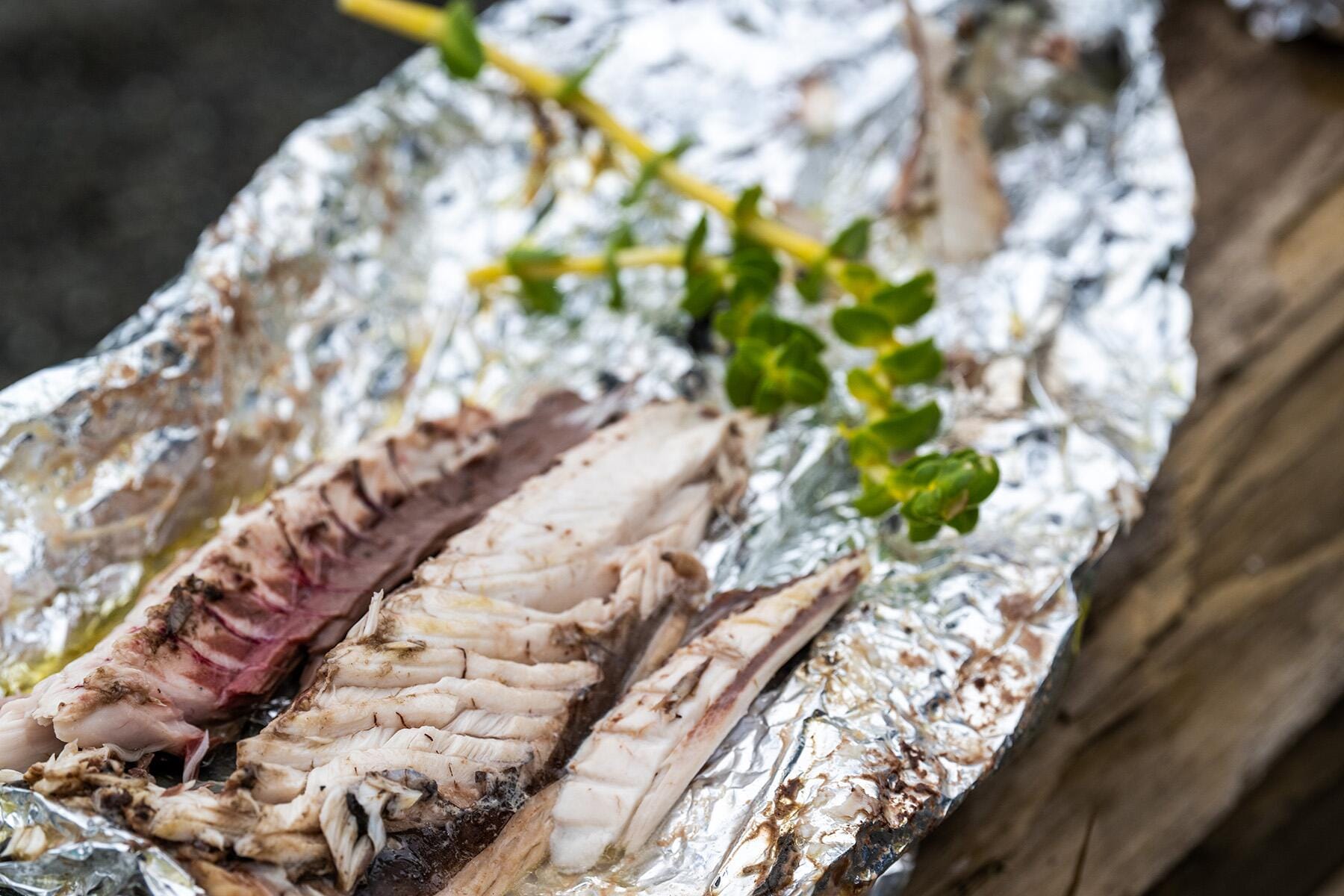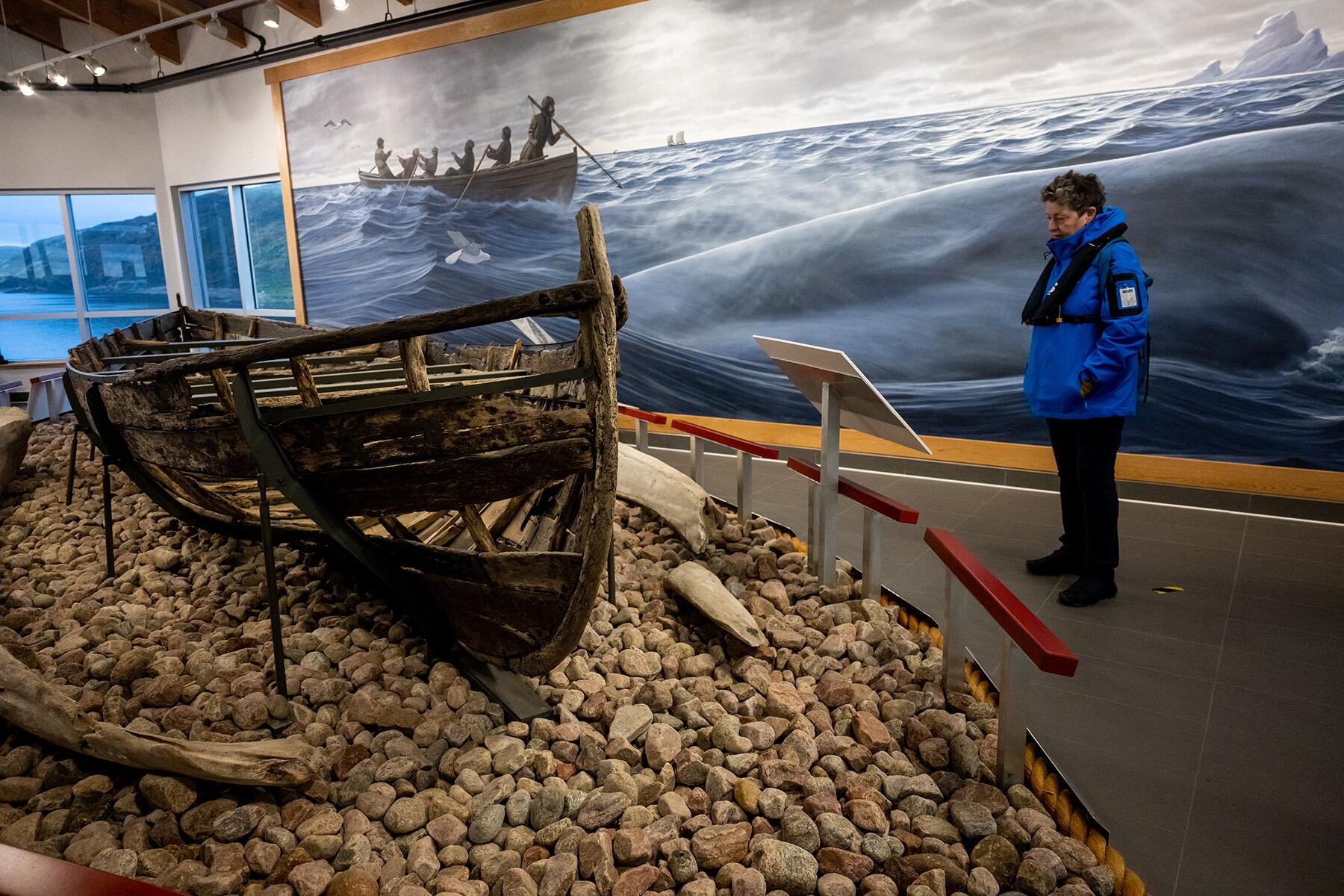Exploring Newfoundland by small ship might be the antidote to over-tourism.
Aclothesline tied between two pieces of driftwood has a sign that reads: “On-Line Shopping.” Hand-knit socks and mittens are usually clipped to it, but in early October, Whale Tale Treasures in Trout River, Newfoundland, is closed for the season. Down the boardwalk, two men duck inside a blue shed, most notable among the long row of colorful fishing shacks because of the whale ribs that frame the door, meeting above it at a gigantic vertebra. I wonder if it’s from the blue whale that famously washed ashore in 2014. At the far end, we watch a fishing boat return, its deck loaded with three crates of still-thrashing fish.
“Wouldn’t it be cool if we could get a few fish from these guys and cook them on the beach?” asks our Adventure Canada guide, Barb Parsons-Sooley.
This is the prelude to the Eastern Point Trail hike that about 25 of us on a 12-day expedition-style cruise circumnavigating Newfoundland selected as part of our shore day at Gross Morne National Park. It promises to be a scenery-packed hike that starts on the beach at Trout River and climbs to a clifftop trail overlooking the St. Lawrence Gulf off the western shore. While some guests embrace Barb’s idea, a few voice concerns that it will impact the hike. The Adventure Canada expedition team—all of them Newfoundlanders—confers, and within 90 seconds, they activate a plan to do both.
The fishermen gift us half a dozen large mackerel, and one guide takes them off to clean. Another goes to find foil and matches while Barb sends the rest of us to comb the beach for driftwood to make a fire. We drop our armloads in a pile at the far end of the beach and then begin the hike, which is as spectacular as promised. While we’re away, the guides who stayed behind build a fire and prepare the fish.
Recommended Fodor’s Video
When we return to the beach, the remains of the fire are smoking, the foil packs have been opened, and we all eat flakes of perfectly cooked fish with our fingers. A salty-tasting plant called sea wort is passed around as seasoning. We’re all a bit giddy amid this unscripted experience that is the essence of Newfoundland and Adventure Canada’s mission: to engage, entertain, and educate by connecting people and the land through innovative travel experiences. This is exactly the kind of experience I’d hoped for when planning this trip.
A Love for Newfoundland
I have been in love with Newfoundlanders and their homeland and history since visiting with my husband 20 years ago. We still talk about the house we almost bought and the fantasy of selling coffee and cinnamon buns while guiding kayak tours to a nearby lighthouse. I read works by Newfoundland writers, and the Dictionary of Newfoundland English sits beside my bed. I had always wanted to return to scratch a little deeper, and I was delighted when I discovered Adventure Canada. This family-owned company specializes in small-ship expedition cruises to the world’s most beautiful and seldom-visited coastlines. Though their itineraries move across the Arctic, Atlantic Canada, and Europe, Newfoundland is one of their most popular itineraries.
The 12-day expedition-style cruise to explore Newfoundland by boat checks all my boxes. Along with up to 168 other guests and an expedition team of 36 stacked deep with Newfoundland scientists, naturalists, storytellers, and musicians, we’ll circumnavigate the island province with daily shore visits to far-flung outport fishing villages, national parks, a First Nations community, three UNESCO World Heritage Sites, and even the French island of St. Pierre off the southern coast of Newfoundland.
The ice vessel Ocean Endeavor—which winters in Antarctica—can maneuver into areas off-limits to larger ships, and its Zodiac boat fleet covers distances of only 5-15 minutes to get everyone to shore. Though I’ll be traveling alone, I am confident that my fellow travelers will share my adventurous spirit and enthusiasm for Newfoundland.
An Island Like No Other
Newfoundland is a quirky place. Not only does the province have its own dialect, but it also sticks to its own time zone, 1.5 hours earlier than Eastern Standard Time. Newfoundland time is unapologetically tied to the sun, which rises here before anywhere else in North America.
After explorer John Cabot “discovered” Newfoundland in 1497 under King Henry VII’s banner, he reported that there were so many cods that it appeared a person “could walk across their backs.” When salted and preserved, cod were a highly valuable trade item. Soon after, seasonal fishing camps evolved into permanent French and English colonies—the path for England’s claim to the new continent. Cod was the center of Newfoundland life for nearly 500 years.
“It’s in our blood, in our songs, in the way we talk, everything,” explains Toni Kearney, founder of Moratorium Tours, a micro tour company in Conche—way up on the eastern shore of the Great Northern Peninsula, another Adventure Canada stop—that curates immersive visits to outport communities in rural Newfoundland.
Deeply in debt after WWII, Newfoundland joined Canada in 1949, and the federal government began forcing people in remote fishing villages, called outports, to resettle to larger centers to be closer to jobs, education, and health services. Families and communities were separated, unanchored, and figuratively set adrift. Newfoundlanders still mourned those losses, so much so that Resettlement was a theme often shared through firsthand stories onboard the Ocean Endeavor and in the communities we visited.
Finally, industrialization led to overfishing, depleting the cod supply. On July 2nd, 1992, the Canadian government imposed a moratorium banning cod fishing, wiping out five centuries of Newfoundlanders’ way of life.
Born in 1994, Kearney refers to herself as a “Moratorium Child” whose family had to leave the province to earn a living.
“We were born into that time of depression, but it wasn’t really talked about. A lot of outport Newfoundland didn’t know what happened to the fishery and why it went away. We were left with all the trauma and nothing was ever discussed,” she explains.
Now, Kearney and others are talking about it. They see small businesses that support outport tourism—such as Adventure Canada’s port of call to Conche—as the path to rural revitalization.
Travel That Heals and Restores
Exploring Newfoundland by small ship is an antidote to over-tourism. For instance, Conche could never support 200 overnight guests—surpassing its own population—but their parish hall is just right to host a scoff, a delicious fish supper, and a scuff, an evening of music and dancing. Adventure Canada pays the tab—a big hit of income for the historical society and parish hall—the townsfolks provide the hospitality and everybody “has a time.”
At the Red Bay UNESCO World Heritage Site in Labrador, which faces Newfoundland across the narrowest point of the St. Lawrence Gulf, we saw the artifacts from Basque whaling vessels that sunk in 1565 and were rediscovered in 1978. At lunchtime, expedition team member Tony Oxford pulled off a bit of magic to hook us up with the “world’s best fish and chips” at a restaurant that had already closed for the season. Here, 150 of us lined up in two shifts for thick filets of battered and fried cod, washed down with Pineapple Crush soda (a Newfoundland pairing, I was told).
Our Red Bay visit had plentiful activity options for hiking, history, and kayaking (you could only pick two), but that boisterous meal and delicious food are my favorite memories from the stop. It’s made sweeter knowing that our visit provided the community with an extra payday to help sustain them through winter.

Choose Your Own Adventure
Another key component of Adventure Canada trips are daily “choose your own adventures,” designed to get people outside of their comfort zones. Some guests are game to pull themselves up a steep ocean cliff trail by rope or climbing in and out of Zodiacs to walk along the landscape. For me, it was ocean kayaking. I love being on the water and I was determined to see some of Newfoundland’s rugged coastline, colorful fishing shacks, lighthouses, and maybe even some whales and seals from the seat of a kayak.
Guests have to register in advance, pay a surcharge—which presumably covers two expert guides hired as part of the expedition team, as well as the equipment—and sign a waiver saying they know how to perform a “wet exit” while also wearing a spray skirt, a neoprene covering that tightly hooks around the opening of ocean kayaks.
We spent our first full morning at Terra Nova National Park. I eased into this experience and picked a guided “sensory hike” on an easy forest trail and then sat in the sun listening to the Newfoundlanders from our crew and Parks Canada play instruments and sing Newfoundland songs. After lunch on the ship, some 8-10 guests and I met with our kayak guides, Cathy Carroll and Barb Parsons-Sooley, both local gals. They gave us our group name—the Sea Wolves—and fitted our gear, matched partners for tandem boats, and instructed us how to layer clothing for warmth and put on our dry suits.
Our first kayak outing was early the next morning in the outport of Conche. While the rest of the ship was set loose on their own, we began ours. From my early alarm, until we pushed off the rocky beach, I was on an adrenaline-fueled mission. My experienced partner, a solo traveler from Alberta, and I easily worked out our rhythm amid the salt air and the sound of water lapping against the hull. The conversation turned personal, sharing fresh losses, love, and healing. I cried; we laughed; I felt restored. Even after discovering that we’d have to exit our kayaks in open water and climb onto the accompanying Zodiac, I didn’t flinch.
We were all cold when we returned to the Ocean Endeavor. After wiggling out of our dry suits, Carroll suggested we run straight to the sauna to warm up, still wearing our woolen underlayers. The Sea Wolves howled all the way there, bonding as a pack.
After that, I felt more confident going to open-seating meals, finding a table to join, or sipping tea in the library lounge and swapping stories with other guests about their day’s adventures. In no time, I was comfortable on my own, anywhere, from an early morning yoga class to engaging in a meaningful discussion about Reconciliation with Mi’kmaq Chief Mi’sel Joe, who was part of the expedition team.
I enjoyed my cozy stateroom, though it was little more than a double-bunk dorm room with a bathroom (the upper beds could be stowed or folded down). Sometimes, I’d watch some of the expert presentations over a live feed from the comfort of my bed. As the ship closed in on St. John’s, I felt such a sadness at leaving the bubble onboard that had been my home for 12 days. If this hadn’t been the final trip of the year, I seriously would have considered staying on for whatever adventure was next.





